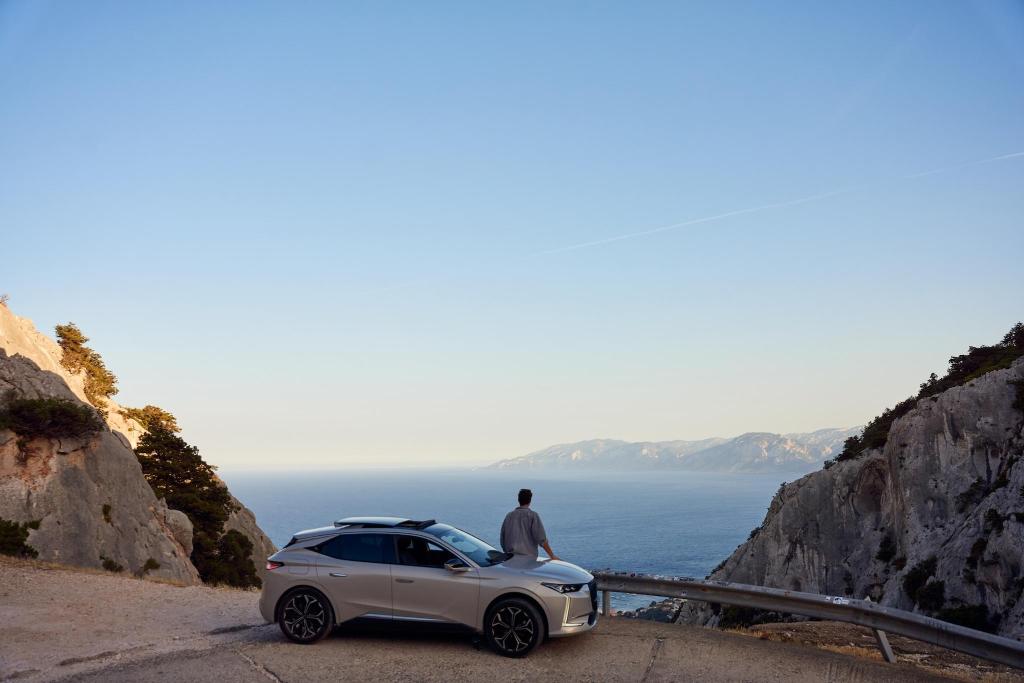
Your guide to electric car rentals
Renting an electric vehicle can be a smart choice for several practical reasons:
- Lowering your carbon footprint
- Potential cost savings
- Driving experience
Electric vehicles, also known as EVs, are becoming an increasingly popular alternative to traditional fuel-powered cars. Running on electricity, they’re smoother, quieter, more efficient, and they eliminate the need for fossil fuels – saving you from paying high fees at gas stations. Whether you’re cruising in a sleek all-electric vehicle or a hybrid that blends the best of both worlds, an EV delivers a fresh, cutting-edge driving experience. This article explains more about the different types of electric vehicles, how they work, and things to consider before renting one.
What is an electric vehicle?

An electric vehicle, or EV, is a single-gear vehicle powered by electricity. EVs don’t require fossil fuel and have no use for an internal combustion engine. Instead, cars run with electric motors using batteries, which can be recharged at public charging stations or a home set-up.
Types of electric vehicles
The difference between types of electric vehicles comes down to how they’re powered.
- Battery Electric Vehicles (BEV) run purely on electricity via a battery.
- e.g. Chevrolet Bolt, Nissan Leaf, Tesla Models Y and 3
- Plug-in Hybrid Electric Vehicles (PHEV) run on a combination of electricity and fuel. The electric battery is used first before the vehicle taps into its fuel reserves.
- e.g. BMW 330e, Hyundai Tucson PHEV, Kia Sportage PHEV
- Hybrid Electric Vehicles (HEV) rely on fuel, but also use an electric battery to assist the engine.
- e.g. Ford Escape Hybrid, Honda CR-V Hybrid, Toyota Prius
Why rent an electric vehicle?
Renting an EV can be a smart choice for several practical reasons:
The environment
Beyond the cool factor of driving something future-forward, electric rental cars are said to be less harmful to the environment than traditional fuel-powered ones. Since EVs don’t burn fossil fuels, they produce zero tailpipe emissions, helping reduce air pollution (and your carbon footprint).
Cost
Another big advantage is cost savings. Whether or not a station charges for its services, charging an EV is generally cheaper than filling up a fuel tank. Now that many rental companies offer EVs at competitive rates to other vehicles in their fleet, renting an EV can save you money in the long run.
Experience
Without the typical engine noise and vibrations of gas-powered vehicles, EVs offer a smoother, quieter, and more relaxing ride. Due to the instant torque provided by an electric motor, EV cars also accelerate much faster and are more responsive when you steer and brake. With more maneuvering control, you may end up feeling more confident behind the wheel.
Considerations when renting an electric vehicle

One of the most important factors to consider when renting an EV is its driving range, which refers to how far it can travel on a single charge before running out of battery. The Tesla Model Y, for example, has a driving range of up to 330 miles, while the Fiat 500e only covers an estimated 141 miles before needing a recharge.
Before hitting the road, EV drivers must map out their route ahead of time to ensure they reach charging stations before their vehicle’s battery dies. Additionally, charging an EV generally takes longer than refueling a fuel-powered car, so drivers need to budget additional time to account for charging stops.
An EV battery’s performance is also impacted by weather and terrain. Extreme cold or heat, as well as driving on hilly or unpaved roads, drains the battery faster than in optimal driving conditions. Being aware of these factors helps you stay prepared and adjust travel plans when needed.
How to charge an electric vehicle

EVs are powered by batteries, which can be recharged at designated electric vehicle charging stations by plugging an electrical cord into an EV’s charging port. While fully electric vehicles are limited to this source of power, hybrid vehicles can be recharged at a charging station or refilled at a fuel station.
Where to find electric vehicle charging stations
There are over 70,000* charging stations and more than 198,000* EV charging ports across the US, and more are being added every day. In addition to standalone stations, charging ports can be found at curbside locations, municipal parking areas, and even some hotels.
Many electric cars have built-in navigation systems that pinpoint nearby charging stations. Apps like PlugShare and ChargeHub** also provide databases of charging stations that can be filtered by location, charger type, availability, and pricing – not to mention built-in trip-planning tools that assist in mapping out future top-ups.
*The above information was sourced from the US Department of Energy’s website in January 2025.
**Disclaimer: The views and opinions expressed are those of the author and do not necessarily reflect the official policy or position of our company.
Do you have to return an electric rental car fully charged?

A rental company will never require you to charge an electric rental car to 100%. That said, most companies request you return the car with at least the same charge level as when you picked it up – though guidelines vary between agencies.
Hertz, for example, caps the refill limit at 75% battery life,* and offers three options when returning electric rental cars:
- Prepay for the starting battery charge and return the vehicle at any battery level.
- Recharge the vehicle yourself and return it within 5% of the original battery level.
- Pay for the company to recharge the vehicle based on the kWh needed to reach the original battery level.
To avoid unexpected charges, check the terms of your rental agreement, and feel free to ask the rental agency about nearby charging stations you can use before returning the car.
*The above information was sourced from the official company’s website in January 2025.
FAQs
How long does it take to charge an electric car?
The charging time of an EV depends on several factors, including the vehicle’s battery size and the type of charger used.
Larger batteries power vehicles for longer distances but require more energy. Plug-in hybrid vehicles have smaller batteries than all-electric models, meaning they take less time to charge but can’t travel as many miles on a single charge.
Plug-in hybrid models generally travel up to 35 miles on a single charge, which takes 2–3 hours to replenish. In contrast, all-electric models travel upwards of 400–500 miles, but take anywhere from 8–12 hours to fully recharge.
Pay attention to the level of charger you use. Level 2 chargers typically add 20 miles per hour to a car’s battery, while Level 3 chargers add 10–20 miles per minute.
Is it okay to partially charge an electric car?
Partially charging an electric car is not only okay – it’s often preferred. Partial recharges help maintain the vehicle’s battery health, as lithium batteries operate best when they are at 20–80%.
That said, charging your car to 100% is perfectly fine if you’re preparing for a long journey. You also shouldn’t let the car’s battery dip below 20%, but even that is acceptable from time to time. In general, avoid exceeding 80% or dipping below 20% on a consistent and prolonged basis, which accelerates the battery’s wear and tear.
What happens if I completely run out of charge during my trip?
Unlike a fuel-powered car, which is able to “run on fumes” for a short distance after the fuel gauge reads empty, an electric car doesn’t have energy reserves to tap into. When the battery reaches 0%, an electric car simply stops driving. A few functions remain on, such as navigation, but only for a short time.
Running out of charge doesn’t happen without warning. The car’s dashboard gives you multiple and increasingly urgent alerts that the battery is running low. The safest thing to do when this occurs is to pull off to a safe location on the side of the road, away from moving traffic.
When your electric car's battery runs out, your only options are to contact roadside assistance or a flatbed tow truck to reach the nearest charging station.
Can I overcharge my electric car?
Electric cars have a built-in system that stops the charging process once batteries reach 100%. That said, many manufacturers advise against charging electric cars to full capacity, as this can shorten the battery’s lifespan if done regularly.
Some vehicles and chargers allow users to set a charge limit, after which charging stops. A charge of 80% is recommended.

- Luxury travel
- Adventure travel
- US travel
 Do you have to clean a rental car?4 August 2025
Do you have to clean a rental car?4 August 2025 How to find car rentals with unlimited miles4 August 2025
How to find car rentals with unlimited miles4 August 2025 Your guide to self-driving rental cars4 August 2025
Your guide to self-driving rental cars4 August 2025 Your guide to crossing national borders in a rental car23 November 2024
Your guide to crossing national borders in a rental car23 November 2024 Timeline for Receiving Your Rental Car Security Deposit Refund21 September 2024
Timeline for Receiving Your Rental Car Security Deposit Refund21 September 2024 All About Booking.com’s Car Rental Cancelation Policy10 August 2024
All About Booking.com’s Car Rental Cancelation Policy10 August 2024 How to choose rental car insurance28 June 2024
How to choose rental car insurance28 June 2024
You might also like these
Lost rental car keys? Learn what to do next and how to manage the situation effectively to minimize stress and costs.
Do you have to clean a rental car? These tips will help you keep vehicles clean during your travels and avoid unexpected cleaning charges afterward.
Finding a car rental with unlimited miles is easier than you think. These expert tips will help you enjoy your trip without worrying about extra fees.
Not sure if you should rent a manual car? In this guide, we discuss how different transmissions can suit your preferences and your license.
Find the perfect family car rental for your next road trip. Choose a vehicle that offers comfort, space, and reliability with our guide.
Navigate US car rental requirements and learn everything you need to know to rent a car as an international traveler.









